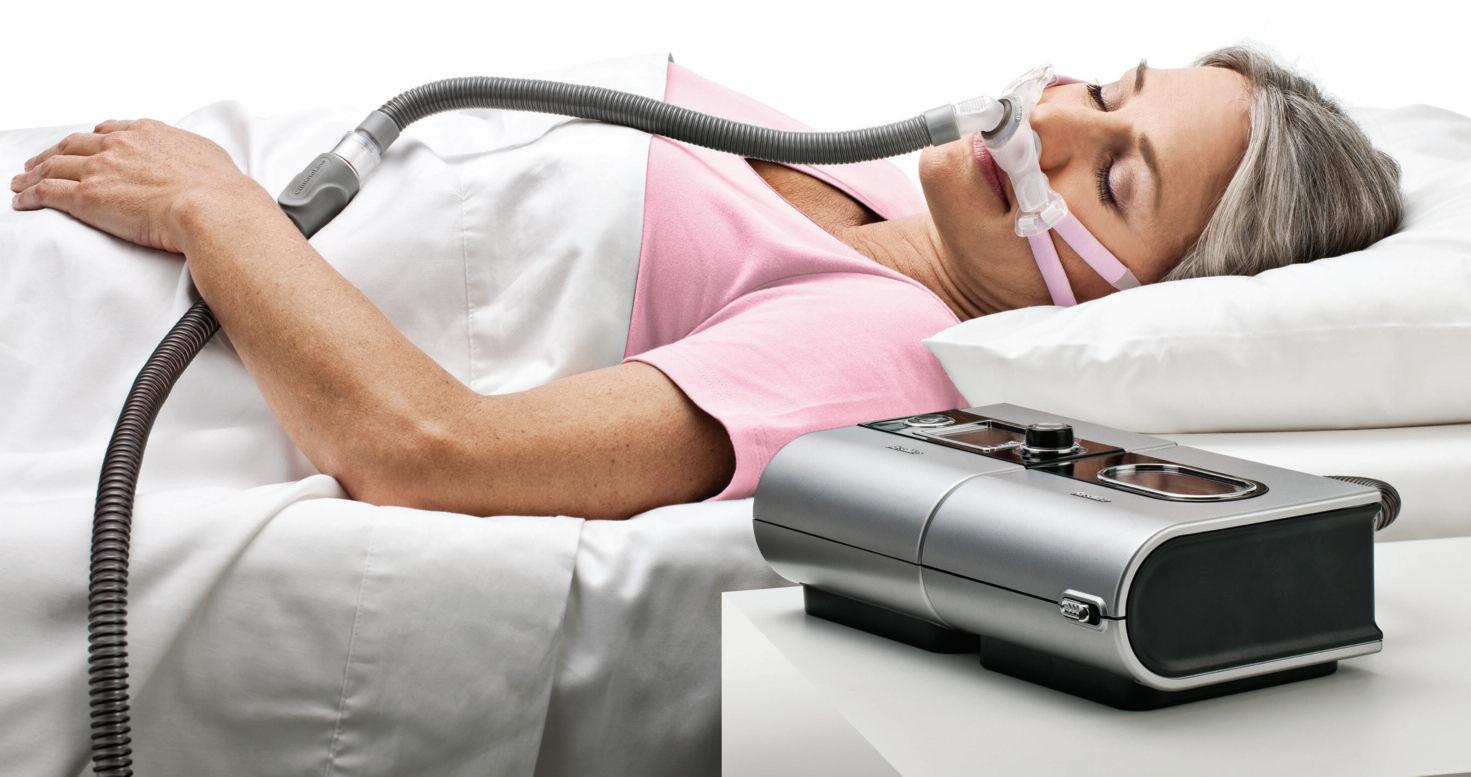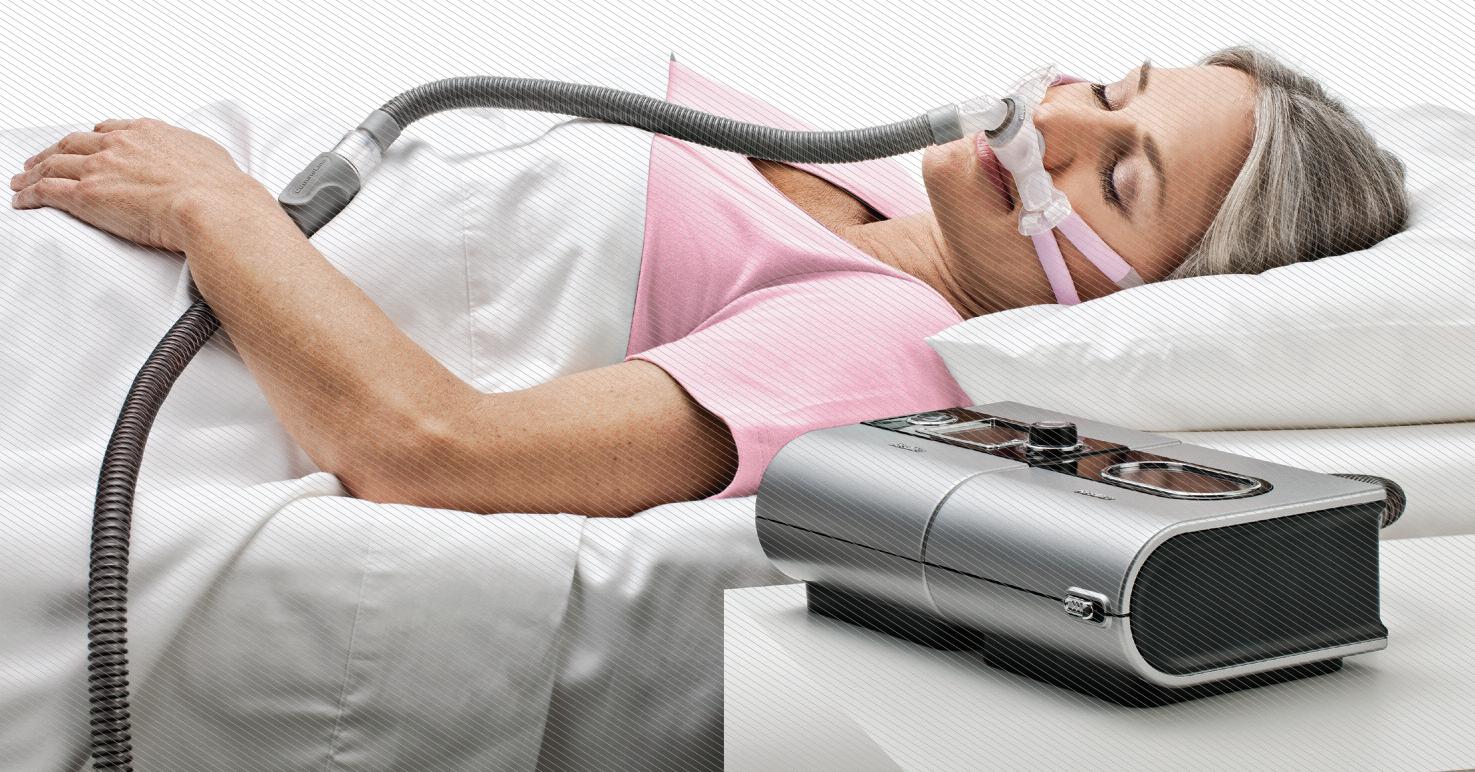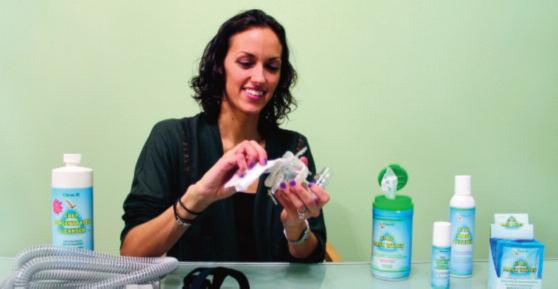
18 minute read
SLEEP APNEA TREATMENT OPTIONS
“A LEAKING MASK COMPROMISES YOUR TREATMENT. ALWAYS CONTACT YOUR SLEEP TREATMENT PROVIDER IF YOU MASK LEAKS OR IF YOU’RE CONSISTENTLY DISLODGING THE MASK AS YOU SLEEP.
W R I T T E N B Y B R A D L E Y E L I , D . D . S .
Advertisement
IF Y O U ’ V E E V E R W A L K E D D O W N T H E T O O T H B R U S H A I S L E I N T A R G E T Y O U ’ V E N O T I C E D T H E R E A R E A W I D E V A R I E T Y O F T O O T H B R U S H M A N U F A C T U R E R S A N D S T Y L E S . Without some guidance from your dental hygienist, it’ s hard to know which is best for you.
It’ s too bad there isn ’t a sleep treatment aisle at Target too, because there are just as many treatment choices. In the last decade sleep treatment has expanded to include many choices in positive airway pressure therapy (commonly known as PAP or CPAP), oral appliance therapy, positional therapy, valve therapy (EPT), and other therapies that can be used singularly or in conjunction with each other. CPAP masks alone have gone from the one-size-fitsall style to over 100 styles, each one designed for a specific patient need. Without guidance from a sleep treatment provider, you may not know which treatment or mask will work best for you.
Our sleep treatment center offers all non-surgical treatment choices. We ' ve made it our mission to help match our patients to their best treatment. That means helping patients explore the wide variety in masks when CPAP is their best treatment option.


SLEEP & WELLNESS MAGAZINE • SPRING 2014 39 Dr. Brad Eli's career is dedicated to patients who face complex pain and sleep challenges and need expert personalized care. He is one of less than 100 doctors in the U.S. with his unique training which includes a post-doctoral master ' s degree and extensive post-graduate education in pain management and sleeps disordered breathing. He is a nationally recognized expert in pain and sleep by both his physician and dentist colleagues, and his practice is devoted solely to these disorders. His primary office is located in Encinitas, California.
If CPAP is your best treatment option, consider these important facts to choose the right mask when you work with your sleep treatment provider:
Bradley Eli, D.D.S.
• There are three major types of CPAP masks on the market today:
1
Nasal pillows – We find these are a good option for patients who are claustrophobic and cannot tolerate a full mask or patients who suffer with mouth, jaw, or facial pain.
WATCH FOR pressure increasing during the night due to leaks and/or nasal dryness.
2
Nasal mask – This mask covers just the nose and is a good option between a full mask and nasal pillows. Many of our patients find this mask more comfortable than nasal pillows and find it stays in place well.
WATCH FOR pressure increasing during the night due to leaks and/or nasal dryness.

3
Oral/Nasal or Full-Face mask – This mask covers both the nose and mouth. It works well for our patients who are mouth breathers at night and those who are not bothered with claustrophobia.
WATCH FOR facial irritation and/or leaking around the mask Masks are like any other medical equipment. They must be cleaned and they have a replacement lifespan to stay effective. Here are our recommendations for cleaning and replacement.
• CLEANING

Clean your mask with mild dish soap and warm water at least once a week. Never put your mask in the dishwasher as it will damage delicate parts. You can use a sponge, cloth, or soft toothbrush to clean your mask.
• A leaking mask compromises your treatment. Always contact your sleep treatment provider if you mask leaks or if you ’ re consistently dislodging the mask as you sleep.
• When using CPAP, it’ s best to sleep on your side. Some patients complain that the mask moves when they sleep on their side. That’ s often because they ’ re restless and can ’t get comfortable. At our center, we ’ ve found helping patients select and use the right pillows makes a huge difference. Using the correct pillows to support neck, shoulder, and hips provides sleep comfort, reduces restlessness, and allows the mask to stay in place throughout the night.
• The comfort of a mask is directly related to the pressure setting. Even the most comfortable mask won ’t feel right if your pressure setting is wrong. So before you change the mask, be sure the pressure setting on your machine is correct.
“Just Try Harder ” is not the proper response to an uncomfortable or ill-fitting mask. If your mask doesn ’t fit or isn ’t comfortable to wear all night, you and your sleep treatment provider need to make adjustments: re-check the pressure setting, use pillows to support your body and encourage side sleeping, check to see if the mask has areas that rub or irritate you. If you ’ re not using your mask all night, you ’ re not effectively treating your sleep apnea. • REPLACEMENT
Watch for wear spots, thinning, and irregularities where the mask touches your skin. Look for fraying or discoloration on the headgear. Be sure there are no unexpected pinholes in any part of the mask or tubing. If you see any of these problems, you may need replacement parts. Breakdown in the seal between mask and skin will cause leakage and compromise your treatment. Headgear that is fraying or pinholes in tubing will also contribute to leakage.
Your mask and tubing should be replaced every three to four months for best results and maximum comfort.
The key to comfortable, restful, healing sleep is matching a sleep patient to his or her best treatment option. For patients who use CPAP, the mask is pivotal. Without a properly fitting mask, it’ s impossible to achieve the best treatment results. Always be sure your mask is clean, comfortable, and well-fitted so you can enjoy the rest and health benefits that result from quality sleep and effective treatment. S&W

FROM A TIGHT CHEST TO GOOD REST

A BREATH OF FRESH AIR FOR ASTHMA SUFFERERS
BR E A T H I N G I S T H E O N LY T H I N G M O R E V I T A L T O Y O U R H E A L T H T H A N S L E E P I N G . Asthma sufferers are on the short end of the breath as they try to gasp themselves to sleep at night. Having struggled most of my life with breathing conditions, I understand how frustrating it is to wake up multiple times in the night for a breather, which is unfortunately the norm for people with asthma.

W R I T T E N B Y J . W A T E R M A N
A longtime asthma sufferer, Sharmin Q said, “I used to wake up a minimum of two to three times per night to
take my puffer and nasal spray. On really bad nights, I would use a sleep apnea device to help me breathe.
Her interrupted sleep pattern left her with low energy and extremely dehydrated from mouth breathing through the night, creating another reason to be awakened. By adopting new lifestyle habits, Sharmin has been added to the roster of happy people who sleep soundly. “Now I sleep through the night and don ’t need those medications, ” she said. She has also switched from a mouth breather to a nose breather, eliminating the need to wake up for a sip of water.

Simple lifestyle changes can quickly take you from a tight chest to a good rest. The results achieved from implementing the right habits can be a breath of fresh air. With just one week of implementation, huge successes have been observed in over 50 cases.

J. Waterman is a Wellness master who reveals that sleep is more important than food and water. He teaches that when sleep is optimized, people thrive. Optimizing his own sleep has made him invincible to sickness, infections and fatigue. His teachings about breathing and its effects on sleep are remarkable and have proven effective for individuals and couples across North America. Waterman is the author of 7Unusual Habits You Need For GoodSleep. His upcoming book, Sleep Sense: Stimulate the 5+ Senses for Anti-Aging Sleep, includes information that can be easily applied to enjoy sleep every night—and life every day.
J. Waterman
HERE ARE TO BLOW ASTHMA AWAY FOR REJUVENATING SLEEP!
(1) Eliminate Dairy: Dairy is a mucus-forming food for many people. If you drink milk and suffer from asthma, it is likely one of the biggest contributing factors to your respiratory challenges. When you lie on your back at night and feel like there is a huge weight on your chest, that’ s the weight of unwanted mucus buildup in the lungs. Eliminating dairy will help reduce excess production of mucus.
(2) Sweat it Out: Get active, and make sure you sweat. As your body heats up, solid mucus becomes liquid, allowing the body to drain it from your lungs and loosening it up enough for you to cough it out. You can accomplish this through exercise, saunas, steam rooms or a hot shower. You can also heat up your insides and melt that mucus by taking a walk outside in the cold. Ever noticed how your nose runs when you are out in the cold? The cold weather causes your body to react by warming up, thus melting the mucus for removal.
(3) Eat Spicy Foods: Add some chili, garlic, ginger or horseradish to your meals, and watch that mucus melt away like the wicked witch of the chest.
(4) Improve Air Quality:
Add negative ions in your bedroom. Negative ions reduce inflammation in the lungs and clean the air, which is like hitting two birds with one stone or, in this case, two lungs with one negativelycharged particle. Studies have shown improved lung function in asthma patients when exposed to enough negative ions. For best results, get a device that emits a minimum of 5000 negative ions per cubic centimeter.
(5) Hypoallergenic
Mattress: If your mattress is 5 years old or older, it is likely laden with dust mites and allergens that hinder optimal breathing conditions. Consider a new mattress, especially one that allows you to change the fabric or sleeping surface in an economical way to maintain a more hygienic environment.
(6) Reduce Stress: Stress causes inflammation. To breathe well while sleeping, you must reduce inflammation. While negative ions clean the air, you must clean your mind. Breathing exercises, thought field therapy, heart coherence, or just a hot bath in Epsom salts are a few amazing ways to help you relax to reduce stress and thus inflammation of the lungs for good sleep.
(7) Eliminate Inflammatory Proteins:
Today ’ s foods contain a large number of indigestible proteins, which can wreak havoc by causing inflammatory conditions throughout the body, including the lungs. Asthma sufferers may avoid problems by eliminating these proteins. Gluten from wheat and casein from dairy can cause inflammation for some people. You can avoid gluten by switching from grains to seeds such as quinoa, buckwheat and millet. Swap dairy for a seed “ milk” such as hemp, sesame or almond. You can swap a few ingredients and still make your favorite recipes without the negative side effects caused by indigestible proteins.
My advice: Try these strategies for 30 days. These beneficial habits will help you reap the rewards of effortless breathing and tranquil sleep. Adopting these habits will help you to get rejuvenating sleep and increase your energy, reduce stress, and let you live a more fulfilling life.
S&W
DREAM



W R I T T E N B Y L A U R I L O E W E N B E R G
“ W e e n t e r a d r e a m s t a t e ( k n o w n a s R E M s l e e p ) every 90 minutes, and dream cycles increase in length throughout the night.
WH A T D O T W I L I G H T , A V A T A R , G O O G L E , T H E S E W I N G M A C H I N E , A N D T H E T H E O R Y O F R E L A T I V I T Y H A V E I N C O M M O N ? They were all inspired by a dream—the kind of dream that you have when you sleep. Artists, writers, inventors and scientists throughout history have solved problems and drawn great inspiration from their dreams. You are literally “dreaming up ” great ideas and personal solutions each and every night too.
We dream every night, whether we remember our dreams or not. We enter a dream state (known as REM sleep) every 90 minutes, and dream cycles increase in length throughout the night. The first dream of the night may only be three minutes, while the last dream before waking (after 7-8 hours of sleep) can be 45 minutes to an hour long. On average, you dream about five times every night. If you live to a ripe old age, you will have had over 100,000 dreams throughout your lifetime! That’ s a lot of great ideas, advice and solutions that unfortunately will go unnoticed, unremembered, or simply dismissed as “just a dream. ” I hope you ’ll never dismiss the dreams you remember again.
What are these movies that play in our heads at night when we sleep? Where do they come from? What purpose do they serve? Does my dream last night about purchasing a baby crib full of spaghetti mean I need to seek professional help?
Since prehistoric times, mankind has wondered about dreams. In 2001, an expedition into the Chauvet Cave in the valley of the Ardèche River in France discovered cave drawings believed to depict a dream. Ancient Romans thought dreams were messages from the gods; many would take pilgrimages to Dream Temples, where they would spend the night in hopes of receiving a dream of wisdom or healing. There are over 700 references to dreams and visions within the pages of the Bible, all suggesting that dreams are messages from God or His angels. The ancient Chinese believed that a dream is when the soul leaves the body to travel the world—and that if a person were awakened suddenly,



< CONTINUED >


Lauri Loewenberg is a Certified Dream Analyst, syndicated columnist, author, popular radio personality, speaker, and member the International Association for the Study of Dreams. She has analyzed and researched over 75,000 dreams from people of all walks of life. She has been a guest on numerous television programs, including The Dr. Oz Show, the View, Good Morning America, and The Today Show. She has also been a recurring guest on nationally syndicated radio shows and has been featured in many magazines, including Esquire, Glamour, and Prevention. Lauri’ s third book, Dream on It: Unlock Your Dreams, Change Your Life, is available in bookstores or from her web site, www.lauriloewenberg.com. Lauri is also a self-taught artist and enjoys bringing her own dreams to life through her artwork. Lauri lives in Tampa, Florida, with her strikingly handsome husband and very loud son.
Lauri Loewenberg
the soul might fail to return to the body. These beliefs reflect that dreaming is a powerful experience and is connected to something greater than ourselves.
The Greek philosopher Plato was one of the first to believe that dreams come from within instead of from an outside source; he believed dreams originated from the liver. Two thousand years later, Sigmund Freud, the father of modern psychoanalysis, taught that dreams come from the subconscious self and are about the self, specifically the sexually suppressed self. Freud’ s protégé, Carl Gustav Jung, taught that dreams come from the self, are about the self, and that understanding dreams helps us improve ourselves. I subscribe to Jungian dream philosophy that everything in our dreams is connected to some part of the self or to something or someone that directly affects the self.
There are common archetypes (symbols, images and themes) that appear in dreams that hold a collective or shared meaning for almost all of us. For example, an unfamiliar woman (that is, one who does not exist in reality) in your dream is your Anima, your female energy, or that part of you that is sensitive, caring and creative. An unfamiliar man is your Animus, your male energy, that part of you that is assertive and takes action. An unknown child is your fun-loving, carefree self or your childish, naïve self. The condition of these archetypes and the way they behave in the dream reflect how well or how poorly you are using these parts of your self in the waking world.
I believe that dream analysis, medically known as oneiroscopy, is the most insightful form of self discovery available. I believe that dreams are insightful and powerful thoughts. When you are dreaming, you are thinking on a deeper and more focused level than when you ’ re awake. When you go to sleep, the world around you is shut out. There are no distractions. Your mind doesn ’t stop working at this point. As your conscious, literal mind slips into a state of rest, your subconscious mind takes over. When you enter REM sleep, the pons, a structure located on the brain stem, signals to the cerebral cortex (the region of the brain responsible for most of our thought processes) that dreaming has begun; subsequent thoughts are expressed using the images, experiences, and emotions of your dreams.
Dreams can be bizarre because when you dream, you think with metaphors. “He ’ s as healthy as a horse. ” “It’ s raining cats and dogs. ” Metaphors compare two things to create a picture that helps us make our point. The next time you have a conversation, take a mental note of how many metaphors are used between you and the other person. We naturally communicate this way. Dreams work in the same way, except rather than speaking the metaphor, they bring it to life.
Suppose you dream of drowning. When you wake up and catch your breath, ask yourself what part of your life could be compared to drowning? Where in your life are you having a hard time staying afloat? What’ s bringing you down? Like a metaphor, your dreams illustrate what’ s going on in your life, how you truly feel about it, and even what you need to do about it!
Through our dreams, we speak to ourselves about what is going on in our lives. We guide ourselves through difficult situations, and we point ourselves toward what we really need to live the life we are meant to live.
When you understand your dreams, you ’ll find they are the best glimpse of reality available. They are how you are brutally honest with yourself when your conscious waking mind refuses to be. A recurring dream is the way you nag yourself over a behavior you need to correct or an issue that needs more attention. Dreams can serve as your friend and advisor when you need to make a tough decision or solve a difficult problem. YOU are the one who truly knows what is best for you! The truth is, your best thinking isn ’t done in the shower; it’ s done while you dream. When we say, “Let me sleep on it, ” what we ’ re really saying is, “Let me DREAM on it. ”


S&W








